Lake Burley Griffin Self-Guided Walking Tour
- Home
- Attractions
- Take a Tour
- Lake Burley Griffin Self-Guided Walking Tour
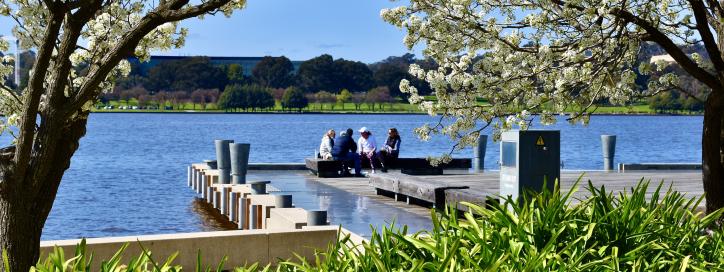
The Heart of Canberra: A Journey Around Lake Burley Griffin
Embark on a journey around picturesque Lake Burley Griffin, Canberra’s iconic centrepiece. Explore a diverse range of landmarks, memorials, and cultural institutions on the shoreline.
For at least 25,000 years the Ngunnawal people have thrived on this land, cultivating deep connections to the Molonglo River and its surroundings. Their sustainable practices, including fire-stick farming, played a crucial role in shaping the landscape and ultimately influencing the location of the nation’s capital.
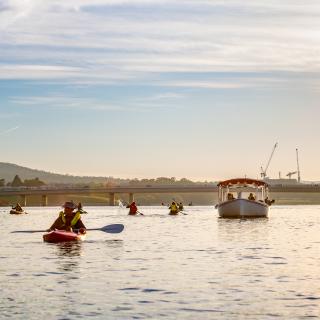
In 1908 the Yass Canberra region was identified by Chief Surveyor Charles Scrivener as an ideal location for the National Capital, Scrivener favoured the site primarily for its beauty and rich resources.
In 1912, the visionary architects Walter and Marion Griffin envisioned a central lake surrounded by parks and gardens. Their prize-winning design has transformed Canberra’s landscape into a harmonious blend of nature and urban design.
On 20 September 1963, the completion of Scrivener Dam allowed the Molonglo River to fill the basin, creating Lake Burley Griffin. Although initially a muddy puddle, the lake eventually filled to its full glory.
Inaugurated by Prime Minister Sir Robert Menzies on 17 October 1964, Lake Burley Griffin has become a beloved symbol of Canberra’s spirit and vision. It’s a place where locals and visitors alike gather to enjoy the outdoors, participate in cultural events, and simply relax by the water’s edge.
1. National Capital Exhibition
Immerse yourself in the captivating story of Canberra. Learn about the Ngunnawal people’s 25,000-year stewardship of the land, which provided the perfect location for the National Capital. Explore the visionary 1912 Griffin design that laid the foundation for a sustainable future.

2. Commonwealth Park
A central green haven envisioned by Walter Burley Griffin. Dame Sylvia Crowe’s master plan, implemented in 1965, transformed this 34.5ha space into a haven for relaxation and enjoyment.
3. Grey-headed Flying Foxes
Witness these fascinating mammals in Commonwealth Park. They play a vital role in the park’s ecosystem, ensuring its health and growth by pollinating and dispersing seeds of native trees. Their increasing presence reflects their adaptation to urban environments.
4. Sir Robert Menzies Walk
Take a stroll along this lakeside path, named after the Prime Minister who championed the lake’s creation. During his time in office (1949-1966), Menzies committed to building a capital worthy of the nation.
5. Captain James Cook Memorial and Globe
Witness the power of hydraulic engineering! This stunning memorial, featuring a water jet shooting 152 meters into the air, commemorates Captain Cook’s historic voyage to Australia’s east coast in 1770. Designed by renowned architect Walter Bunning, the memorial is a striking landmark.
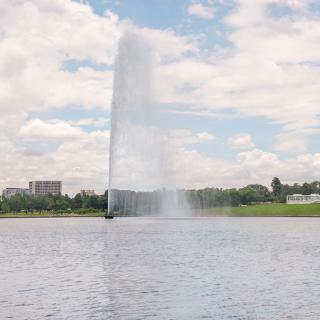
6. Citizenship Place
Discover the story of Australian citizenship at this symbolic location. A historic timeline adorns the rusticated wall, tracing the journey of early citizenship. Here, you’ll also find a powerful affirmation that unites all Australian citizens.
7. Sir Robert Menzies Statue
Pause to admire this impressive life-size statue by Peter Corlett. Depicting Menzies in motion walking by the lake he championed, this sculpture honours Australia’s longest-serving Prime Minister.
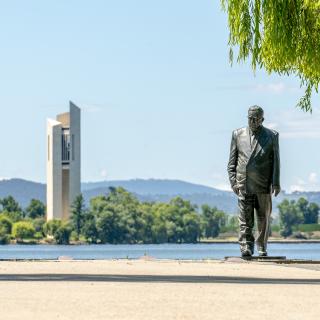
8. Site of Murray’s Bakery
This site marks the location of the capital’s earliest commercial bakery. The Murray family opened their bakery in 1911, with nine sons delivering bread throughout the district. Though a fire destroyed the bakery in 1923, the elm trees that remain offer a glimpse into the colonial past.
9. Gallipoli Reach
Named after the historic battle site in Turkey, Gallipoli Reach commemorates the courage of ANZAC and Turkish forces. The lake’s contours mirror the shape of Anzac Cove, creating a poignant connection to this significant event.
10. Rond Terrace
Originally designed as a parade ground, Rond Terrace aligns with the central Land Axis of the Griffin design. From here, you can appreciate the stunning symmetry of the landscape, with Mount Ainslie framing Parliament House across the lake.
11. National Emergency Services Memorial
This memorial honours the brave men and women who serve in Australia’s emergency services. It provides a place to reflect on those who have sacrificed their lives in the line of duty.
12. Blundells Cottage
Step back in time at Blundells Cottage, a charming 1860s worker’s cottage. This historic home witnessed the evolution of Canberra, housing three families and numerous boarders over a century.

13. Indian Ocean Tsunami Memorial
Reflect on the devastating impact of the 2004 Boxing Day tsunami at this poignant memorial. It honours the Australian victims and the brave emergency services who responded.
14. National Site of Recognition for Thalidomide Survivors and their Families
This contemplative space acknowledges the enduring impact of thalidomide. A symbolic glass brick gateway and etched timeline provide a place for reflection and education.
15. Merchant Navy’s Memorial
Honour the vital contribution of the Merchant Navy during both World Wars at this memorial. Its location at the lake’s edge reflects the Navy’s strong association with water.
16. HMAS Canberra Memorial
Commemorate the sinking of HMAS Canberra during the Battle of Savo Island in 1942. This memorial features a five-tonne anchor and chain, a poignant reminder of the ship’s tragic fate.
17. National Carillon
Admire this stunning bell tower, a gift from the British Government to commemorate Canberra’s 50th anniversary. Its 57 bells, ranging from 8.9 kilograms to 6 tonnes, offer a mesmerising musical experience when played via a clavier.
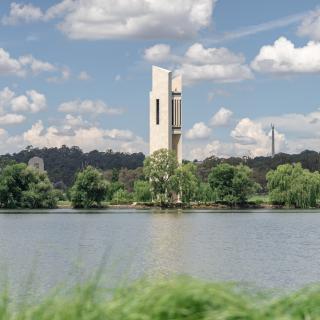
18. National Police Memorial
Honour the brave men and women of the Australian police force at this memorial. Bronze plaques commemorate those who have lost their lives in the line of duty. The tilting stone-paved area symbolizes the uncertain path that police officers face each day.
19. National Workers Memorial
Celebrate the contribution of Australian workers and remember those who have lost their lives in work-related incidents. This memorial honours their sacrifice and dedication.
20. Kings Avenue Bridge
Admire this iconic bridge, originally named Federal Avenue. It forms a key part of the symbolic triangle, along with Constitution and Commonwealth Avenues, at the heart of the Griffin design.
21. Sculpture Garden
Enjoy the contrast of nature and architecture in this serene garden. Designed to soften the National Gallery’s bold lines, the sculpture garden offers a peaceful space to appreciate public art amidst native plantings.
22. Reconciliation Place
Discover captivating artworks and celebrate Australia’s shared cultural heritage. Explore themes of Indigenous achievements, partnerships, belonging, and connection to the land and waters. This significant location, bookended by the National Library of Australia and High Court of Australia, provides a space for reflection and understanding.
23. Commonwealth Place
Discover this vibrant community venue in the heart of the nation’s capital. The striking 10-metre square pavement artwork, a gift from the Canadian Government to mark Australia’s Centenary of Federation in 2001, reinforces the Griffin’s Land Axis and serves as a gateway to the parliamentary area.
24. International Flag Display
Witness a stunning display of over 100 flags representing nations with a diplomatic presence in Canberra. This impressive collection, possibly the largest in the world, further acknowledges the city’s international significance.
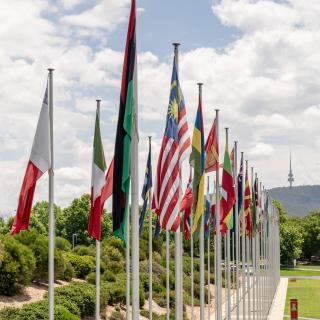
25. Peace Park
Commissioned during the 1986 United Nations Year of Peace, this serene park symbolises Australia’s commitment to harmony. It offers a tranquil space for contemplation and reflection.
26. Australians of the Year Walk
Celebrate the achievements of Australia’s outstanding citizens. This walk recognises individuals who have made significant contributions to the nation. The pathway’s design incorporates elements of the music score of ‘Advance Australia Fair.’
27. Commonwealth Avenue Bridge
Admire this iconic bridge, which has witnessed the transformation of Lake Burley Griffin. Originally built over a mud flat, the bridge now stands proudly above the lake. It incorporates historic stone remnants from London’s Waterloo Bridge which can be found under the bridge, on the northern shore.
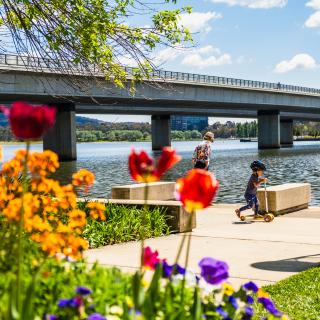
Explore Further
Embark on a journey through Canberra’s rich history and stunning landscapes. Choose from a variety of self-guided walking or driving tours.
Retrace the steps of Anzac heroes or uncover the stories whispered by the Old Parliament House Gardens. The Reconciliation Place Walking Tour offers a chance to connect with Australia’s rich Indigenous heritage, while the Diplomatic Missions Driving Tour unveils Canberra’s international significance.
Prefer a guided experience? Simply call the National Capital Exhibition at (02) 6272 2902 to book your spot.

Getting Around Lake Burley Griffin
Walking the Shoreline
Stroll around the central basin, taking in stunning views and vibrant cafes. This 5km loop, known as the ‘Bridge-to-Bridge’ walk,
connects Commonwealth Bridge and Kings Avenue Bridge. Many sections are dog friendly.
Cycling the Lake
Explore Canberra’s scenic cycling paths. Choose from various routes, including the 16km Western Loop, taking you past iconic
landmarks like the National Museum of Australia and the National Arboretum.
Lake Cruises
Experience Canberra from a unique perspective. Glide past stunning waterfront views and admire the Brindabella Mountains on a leisurely lake cruise.
- Attractions
- Events
- Education
- Planning
- Planning in the National Capital
- Works Approval
- Heritage
- Heritage Strategy
- Heritage Management Plans
- ANZAC Parade Heritage Management Plan
- Acton Complex Draft Heritage Management Plan
- Australian American Memorial and Sir Thomas Blamey Square Heritage Management Plan
- Blundells Cottage Heritage Management Plan
- Changi Chapel Heritage Management Plan
- Commencement Column Monument HMP
- General Bridges Grave Heritage Management Plan
- High Court – National Gallery Precinct HMP
- King George V Memorial Heritage Management Plan
- Lake Burley Griffin and Adjacent Lands Heritage Management Plan
- National Carillon and Aspen Island Heritage Management Plan
- National Rose Gardens Heritage Management Plan
- Old Parliament House Gardens Heritage Management Plan
- Parliament House Vista Heritage Management Plan
- State Circle Cutting Heritage Management Plan
- Surveyors Hut and Surveyors Park Heritage Management Plan
- York Park Heritage Management Plan
- Heritage Management Plans under consultation
- Heritage Management Plans previous consultations
- Consultations
- Plans, policies and guidelines
- National Capital Plan
- Heritage Management Plans
- Planning Policy Review
- Urban design
- Acton Peninsula Precinct Structure Plan
- City and Gateway Urban Design Framework
- Constitution Avenue Public Realm Handbook
- Creating Places for People and Road User Hierarchy
- Deakin Forrest Residential Precinct Guidelines
- Guidelines for Commemorative Works in the National Capital
- Guidelines for Perimeter Security in the National Capital
- Outdoor Lighting Policy
- Parliamentary Zone Review
- The Griffin Legacy
- Tree Management Policy
- West Basin Precinct Guidelines
- Yarralumla Bay Recreational Hub Master Plan
- Your Capital, Your Say
- Environment
- National Land management
- Asset management
- Lake Burley Griffin
- NCA Projects
- Current NCA Projects
- Past NCA Projects
- Anzac Parade works
- Blundells Cottage Conservation and Interpretation Project
- Boundless Playground Picnic Deck
- Boundless parking extension
- Bowen Place Crossing
- Captain Cook Memorial Jet Upgrade Works
- Car Park Upgrades
- Commonwealth Park Lighting Replacement
- Dame Dorothy Tangney and Dame Enid Lyons Sculpture
- Draft Tree Management Policy
- Dunrossil Drive Pine Tree Replacement
- Furniture upgrade in Commonwealth Park
- High Mast Lighting
- International Flag Display Extension & Lighting Upgrade
- Interpretive Signage in the National Triangle
- John Gorton Building Car Park Upgrade & Associated Works
- John Gorton Building East Car Park Car Park Lighting Replacement Works
- King George V Memorial Works
- Kings Avenue Overpass
- Kings Park Improvements
- Lake Burley Griffin Wall Renewal Program
- Landscape Renewal at the Forecourt of the National Library of Australia
- Merchant Navy War Memorial Upgrade
- National Carillon Upgrade Works
- National Gallery of Australia Foreshore Upgrade
- Old Parliament House Gardens – rose name signage
- Regatta Point Redevelopment
- Restoration Works for the National Emergency Services Memorial
- Scrivener Dam Anchor Bolt Remediation
- Sir John Gorton Sculpture
- Sir John McEwen / National Party of Australia Centenary Commemoration
- Stirling Park improvements (Gura Bung Dhaura)
- Public Interest Certificates
- Parking
- About us
- Who we are
- Our Board
- Our Staff
- Volunteers
- Canberra National Memorials Committee
- History of the NCA
- 1913 - 1920 Walter Burley Griffin, Federal Capital Director of Design and Construction
- 1921 - 1924 Federal Capital Advisory Committee
- 1925 - 1930 Federal Capital Commission
- 1938 - 1957 National Capital Planning and Development Committee
- 1958 - 1989 National Capital Development Commission
- National Capital Planning Committee
- 1989 to Present Day National Capital Authority
- What we do
- Corporate documents
- Careers
- Key Governance Documents
- Video gallery
- Who we are
- Media centre
- Contact us
Acknowledgement of Country
We acknowledge the Ngunnawal people as traditional custodians of the ACT and recognise any other people or families with connection to the lands of the ACT and region.
We acknowledge and respect their continuing culture and the contribution they make to the life of this city and this region.
